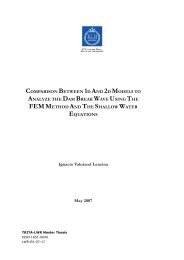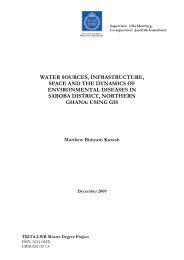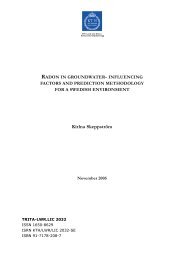POTENTIAL BIOGAS PRODUCTION FROM FISH WASTE AND ...
POTENTIAL BIOGAS PRODUCTION FROM FISH WASTE AND ...
POTENTIAL BIOGAS PRODUCTION FROM FISH WASTE AND ...
You also want an ePaper? Increase the reach of your titles
YUMPU automatically turns print PDFs into web optimized ePapers that Google loves.
Potential Biogas Production from Fish Waste and SludgeStirringMixing is another significant factor in the AD process which can blendthe feed substrate with inoculums amply. It can also prevent theproduction of scum in the surface and sedimentation of substrate at thebottom of the reactor. In addition, it can create the homogeneouscondition to avoid temperature stratification in the digester, as well asincrease the duplication rate of bacteria by gaining nutrients sufficiently.However, the immoderate stirring will destroy the microbes. So properor slow stirring as the auxiliary mixing is the good for the AD (Verma,2002).2.2.3. Inhibition substancesInhibition substances contain VFA, ammonia, other nutrients andtoxicity and some gases, which has potential risk on the AD process.Therefore, the specific principle of inhibition process of thosesubstances and the solution to reduce the degress of inhibition areintroduced in this section.VFAVFA is produced from the acidogenesis process, which contains longercarbon chains than acetate. It could be degraded by acetogenic bacteria.Higher concentration of VFA accumulation could inhibit the methanogenesisprocess. One reason of VFA accumulation can be the presenceof macromolecular organic material that is hard to be decomposeddirectly in the feedstock. The other reason for this inhibition is lowefficiency of VFA decomposition by acetogenic bacteria (Mshandete etal, 2004). If there is an excessive accumulation of VFA leading to anabrupt decrease of pH, a certain amount of alkaline could be added toneutralize the condition and reduce the risk of inhibition to methanogenicarchaea. For instance, calcium carbonate (CaCO 3) could be addedto achieve the molar ratio of bicarbonate to VFA as 1.4:1 at least (Appelset al, 2008).AmmoniaAmmonia is the by-product in the AD process which is mainly fromproteins and other nitrogen-containing organic materials. There are twoforms of ammonia that can be discovered in the AD, i.e. free ammoniagas (NH 3) and ammonia ion (NH 4+). Both of them might bring harmfulimpact on the methanogenic bacteria according to the study ofKayhanian (1999) (Fig. 3). The inhibition process of NH 3Kayhanian (1999) assumes that there is a change of pH in themethanogenic cell when NH 3 might diffuse into it passively. It couldcause that NH 3 is converted to NH 4+ by adsorbing protons from theoutside of the cell. The cost of it is a potassium antiporter to provideenergy for proton balance. The potassium deficiency or protonimbalance inside of the cell might be the consequence of NH 3inhibition. The inhibition process of NH 4+The way of the inhibition of NH 4+ is totally different from theinhibition of NH 3 which stops the methane synthesizing enzymesystem so as to inhibit the CH 4 production from the reaction of H 2and CO 2 (Kayhanian, 1999).NH 3 causes a higher degree of inhibition in comparison to NH 4+(Appels et al, 2008). There are some factors that will increase theconcentration of NH 3. For example, high concentration of NH 3 is7
















